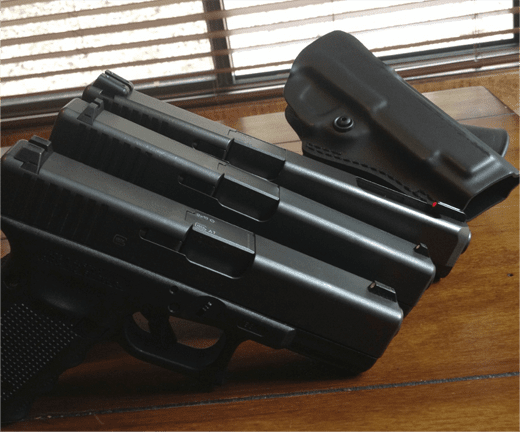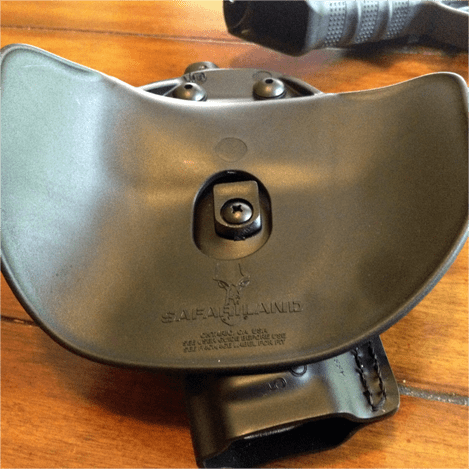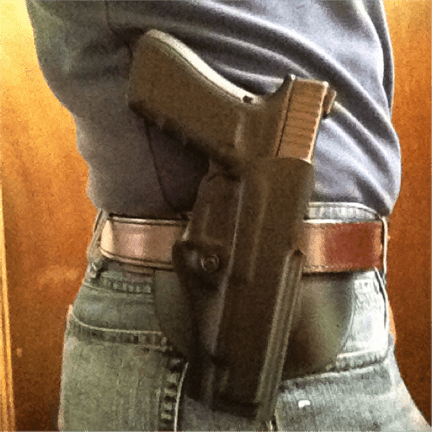By David Blanton
Many new shooters taking the step into the world of action shooting end up starting with a lower end holster. As ubiquitous as the spent brass casings swept to the side of the range are the Fobus, Blade Tech Revolutions, Blackhawk SERPAs and sadly, yes, even some nylon holsters hardly worthy of the designation “holster”. Generally, the folks who stick with competitive shooting will end up with a purpose-built competition holster running $60-80, usually something made by BladeTech, CompTac or a whole host of smaller kydex shops. The 5198 represents Safariland’s entry into the world of high value holsters, and it should be given some serious consideration for new and seasoned shooters alike . . .
Before we dive into what Safariland is offering, let’s lay out a framework for what you want in a competition holster.
First and foremost, competition holsters are usually made out of kydex or molded plastic and are worn on the belt on your strong side hip. While not a dig at leather at all, whatever the material the holster is made of, it must be rigid enough to allow for unassisted re-holstering. The holster may be attached via belt loops, a “paddle” that’s tucked down behind your belt, or some fancy proprietary system with a cool acronym.
Generally the loops or the paddle are most common. Drop offset holsters (where your sidearm would hang down and away from your body, allowing a more natural draw stroke) are allowed in some circumstances, just confirm with the rulebook of whatever sport you’re looking into.
Second (and third), holsters should offer retention appropriate for the sport you’re undertaking. In IDPA and USPSA, the buzzer goes off and the gun comes out, so retention isn’t super-critical. In the world of 3 gun where you will be running with your sidearm holstered, retention becomes a lot more important.
That said, there are three levels of retention in holsters. Level 1 holsters keep the weapon in place with friction alone. Level 2 have friction and some additional movement required to free the weapon (think SERPA or thumb break). Level 3 holsters require two movements to release the weapon. For gaming purposes such as USPSA and IDPA , Level 1 holsters are preferred.
Fourth, a competition holster should stay put both while you’re moving and more importantly during your draw stroke and re-holstering. For this reason, nylon holsters are frowned upon. Any holster that requires assistance from your off hand to re-holster will more than likely get you DQ’d as you will more than likely muzzle your hand, which is frowned upon to say the very least.
Finally, holsters can extend the full length of the slide or can have open bottoms allowing the muzzle to extend down beyond the holster. The full length holsters protect the muzzle and keep the firearm in place should the muzzle be bumped. The downside of this is that it means that the holster is specific to one firearm. Slide holsters are available which can accommodate all lengths of barrels in the same weapons platform (1911, GLOCK, M&P, etc) which offer great flexibility, but limited utility apart from the range. You can order a holster that fits the largest firearm in a platform and smaller firearms will fit as well.

Along those lines, the 5198 does everything you’d want it to. It’s secured to the belt via a paddle or belt loops (5198 comes with a paddle, 5197 comes with belt loops and 5199 comes with a belt clip, but supposedly either can accept the other). It offers Level I retention (adjustable via a screw, just like every holster, ever). And it stays put during the draw stroke through the use of a small stud extending from the holster (not the paddle) and toward the body. The stud is deep enough so that a variety of belts may be used with the 5198, but the design of the paddle is sound enough that it doesn’t usually come to the stud needing to keep the holster put, assuming your holster doesn’t have a death grip on your firearm.

With respect to construction, the injection-molded plastic actually feels like a quality piece of kit. It easily feels stouter than the Fobus paddle holster I got my start in action shooting with, or the GLOCK Sport holster that graces many a hip. It’s on a par with the BladeTech Revolution and Blackhawk SERPA. The high-end Kydex holsters do feel more solid than the 5198, but the 5198 feels “good enough”. The holster is cut away as much as it can be to get your weapon out in a hurry. The 5198 also has the added touch of a little piece of felt inset to protect your weapon’s finish.

There are a couple take-it-or-leave-it features on the 5198 as well. The holster extends down to cover the entire muzzle of the weapon. That great if you’re wearing it off the range and don’t want to run the risk of pushing your weapon up and out of your Level I holster when you sit down wrong. But it also means your longer slide variants of the same platform can’t share holsters unless you order the model for your longest slide length.
My G34 holster fits my G19 & G17, but a G19 holster wouldn’t fit the 34. M&P guys, I can’t comment on your guns, but I would suspect the same holds true. The other feature is the holster is actually designed with a slight forward cant. It’s not as exaggerated as the 15 degree tilt on my CompTac paddle. Some may not like it, but I like cants in my holsters.
Now for the not so great. The ride height very enthusiastically keeps the front strap and trigger well above the belt line in the fullest spirit of IDPA rules, whereas the BladeTechs and CompTacs of the world really push the envelope into “sure it’s legal, you can see daylight between the front strap and belt if you squint and look just right” category. The higher ride height means you have to bend your elbow more to reach the grip, which (marginally) slows your draw stroke. After practicing my draw stroke with the 5198 then switching back to the CompTac paddle, the CompTac felt almost like a drop offset. The 5197 and 5199 appear to ride lower, so I will be ordering the belt clip attachment.
The other ding against the 5198 is how big the paddle is. The paddle is well molded for a strong side hip and not just some lackadaisical curvature that won’t fit an actual shooter’s body (like some paddles out there) but it’s definitely on the larger side. The paddle is in line with similarly priced paddles, but it’s 40-50% larger than my CompTac’s paddle.
Additionally, some higher end holsters modify their paddles to the belt width you intend to use. The Safariland is pretty much set up to what I would guess is as much as a 2” belt, so there is more play in the holster than if it were set up specifically for your belt width. Some paddles feature Velcro patches to hook on to a Velcro-lined or nylon web gun belt, but the 5198 doesn’t sport those.
Can it work as an OWB concealment holster? That depends on the barrel length of the gun you’re trying to hide. The G34 I bought it for is less than ideal for concealment, so the holster is just too long for concealed carry. With my 19, I would expect that it would do better, but even still, the can’t isn’t aggressive enough to really shrink that critical dimension of the muzzle sticking down below a concealment garment.
Finally, there’s value. Safariland is asking $39 plus shipping and handling for this through their holsters.com website. That price point works for a holster of this quality, but if you have the least bit of savviness on the interwebs you’ll be able to take one home in the $28-35 range, all in. At the time of this writing, Safariland is including a 50% + free shipping discount card for holsters.com with new memberships to IDPA, so if you can wait the 10-12 weeks for your new membership packet to show up you can snag one of these for approximately $21, which is an absolute steal.
Whether you’re looking for a practice rig for your SIRT pistol, a backup to bring newbies out to club matches, or looking for something new/different, the 5198 definitely deserves your consideration.
MSRP: $39 + S&H, but you can find them for a lot less.
Ratings (out of five stars):
Concealability: Varies by gun.
Suffice it to say a GLOCK 34 may as well have a neon sign drawing attention to it.
Comfort: * * * * *
As comfortable as coin.
Construction: * * * *
I don’t expect any issues from it, but you can tell there’s a difference from the pricier competition holsters.
Overall: * * * ½
It’s difficult to rate something overall since we tend to temper our expectation for a product by what we paid for it rather than using some objective standard. I went with the “objective standard” route. If I were to go by value, it’d be four stars.





$39 is inexpensive. The Comptac I got was about $60. Cheap nylon holsters are one of the few things I hate in life. I do a facepalm when I see someones pistol bouncing all over their hip in their Cheap $10 holster with every step they take.
I like the 5198 substantially more than the Fobus paddle.
Does this holster accept all Safariland patterned attachment points?
The screw pattern attaching the paddle is the same for all of the Safariland holsters, so the website says.
I have the next step up in this holster with a thumb-activated retention lock, for woods carry, some colder weather concealed carry but mostly for teaching / RSO time when I open carry. The thumb tab does not slow the draw stroke and it solidly holds my Glock 20 or 29, heavier pistols, pretty comfortably.
Some of the LEOs who shoot IDPA with me will run their Level 3 Safariland holsters sometimes, it does affect their first shot times, but not as badly as you would think. But they’re all very competitive Experts (as in their classification in IDPA) , so YMMV for lesser mortals.
While it certainly looks nicer than a Fobus, I don’t see how it is any better. The lowly fobus is easy on and off and very tunable. I have been using them for my “occasional” competition guns for years.
Of course, if the street price of this is $30, its only $5 more than a fobus and may be worth it just for the looks. To each his own.
Don
Depends on what you mean by “better”. A Fobus retains your weapon as well as a high end holster, but the execution is not near as pretty. The Safariland has a smoother draw and a more positive “click” when it is holstered than did my Fobus. The Safariland is more cash, sure, but it’s a $5-10 investment I would recommend making. Especially if you are a new IDPA member and can get it for $21. For $21 this is the best thing going.
I have read where the paddle should go inside the pants instead of inside the belt,
A paddle like this, I agree, should go inside the pants. I photographed it outside the pants simply to illustrate how large it is. Since the hook is on the body of the holster, that is what is holding it onto your belt. The CompTac paddle is intended to be worn outside of your pants as the paddle is bent up to hug the belt, as is the case with the Fobus paddle as well.
Comments are closed.